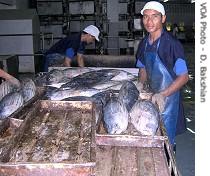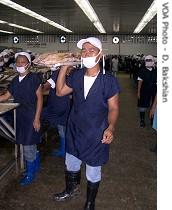2007年VOA标准英语-Philippines Tuna Industry Short of Fish as Glob(在线收听)
General Santos City
06 September 2007
Worldwide tuna catches are falling as demand strains the supply. Tuna stocks in the Atlantic and Mediterranean have dropped, in recent years, prompting a cut in catch quotas. Supplies also appear tight in the Pacific Ocean. Douglas Bakshian recently traveled to General Santos City, home to six of seven tuna canneries in the Philippines, to find out what is happening.
 |
| Cans of tuna |
Madelyn De Manuel, 43, rises at three in the morning to get to work at Ocean Canning Corporation. After a 10-kilometer ride in a jeepney, or mini-bus, she arrives around five at the plant where she cleans fish. Work is awarded on a first-come, first-serve basis.
Out of 600 people who show up in the mornings, only about 400 are employed for most shifts.
Madelyn is paid for the amount of fish she cleans, and she has seen a big drop in her income. She averages almost four dollars a day, but that is down from $5.50 in recent months.
She has six children and a husband who works as a security guard, and the family is feeling the financial pinch.
"We have to budget the income. Before if you can buy some meat, now only vegetables, salted fish," she explains.
The cannery normally operates 24 hours a day. But for the first time in its 10-year history, it is down to one eight-hour canning shift. The ships are bringing back fewer fish and there is little to can.
Plant manager Mariano Fernandez says he is down to as few as 600 workers a day, from about 1500 in the past few months. Fernandez, who also heads the local cannery association, says all six canneries in General Santos are operating under similar conditions.
"You could just imagine that one purse-seiner, a big vessel, that can load 2,000 metric tons of tuna. They stay there (at sea) for several months and they come home with 300 tons only. So this is unusual."
 |
| Man carries whole tuna |
"There was a crisis for two months, July and August was really, really very bad. Catch maybe for us is around 40 to 45 percent less," he says.
He says other boats have the same problem. However, he says his total . Explanations vary from market forces to nature. Some say the catch in the Indian Ocean is down and Thailand, which normally buys fish there, is purchasing from Filipino ships in the Western Pacific.
"The real scenario of why catching is so bad this year, nobody could safely tell you why it is so," says Paul Candelaria, president of the Philippines Tuna Canning Association. "Some are saying it is because of the migrating pattern, or the feeding pattern after the (2004) tsunami. Some would say this year it is because of the global warming, some would tell you that it is because of over-fishing."
Philippine tuna industry officials get their information from ships at sea and other people in the business. They offer no scientific data to support their observations. That will be left to international organizations that monitor the environment, and it takes time to determine patterns after data is collected.
Environmentalists have warned that tuna could face extinction if current fishing rates continue. A meeting in Japan in January approved the first international plan to save tuna from over-fishing.
Last year, the International Commission for the Conservation of Atlantic Tunas decided to gradually reduce the catch of bluefin.
 |
| Man carries fish |
Whatever the reasons for the tuna shortage, it hurts people in General Santos. Fish cleaner Madelyn De Manuel fears for her job.
"We are very much worried. Because if we have no fish, we have no work," she says.
At the end of August, General Santos held its annual tuna congress and festival, with parades, speeches and other events. But some wonder if there will be anything to celebrate next year.